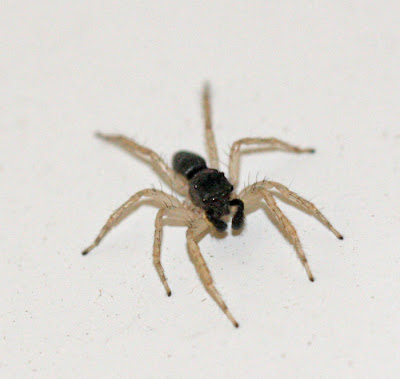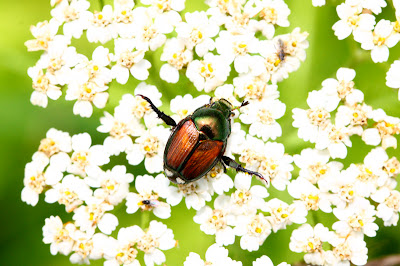Most people have seen a light during a warm, summer night with numerous moths flying around it. The reason for this is often thought to be related to the idea that moths use the moon as a point of reference while flying around or migrating. To moths and other insects, a bright artificial light may look like the moon, so they use that as a guideline rather than the real moon. As a result, the moths get disoriented and flutter around the light.
This disorientation and movement towards the light (not technically "attraction") allows close observation of many insects species that would be difficult to find otherwise. For the past week or so, I have been going out to the porch light after dark and checking to see what shows up. Over the course of about one week, I have recorded about 60 species of moths near the light, as well as numerous species of other insects including mayflies, wasps, beetles, and stink bugs.
 A common moth species this time of year is the Pink-barred Pseudeustrotia (Pseudeustrotia carneola). This species is easily recognized by the two light-colored bands that break up the dark areas of the wing.
A common moth species this time of year is the Pink-barred Pseudeustrotia (Pseudeustrotia carneola). This species is easily recognized by the two light-colored bands that break up the dark areas of the wing.
 Unlike the previous species, the Common Idia (Idia aemula) is a fairly plain species. This is a very light-colored individual.
Unlike the previous species, the Common Idia (Idia aemula) is a fairly plain species. This is a very light-colored individual.
 Moths come in many shapes, sizes, and colors. This Grape Leaf-folder Moth (
Moths come in many shapes, sizes, and colors. This Grape Leaf-folder Moth (Desmia
sp.) is a relatively small moth, with a wingspan of about 2 cm and a distinctive shape and pattern. This yellow moth,
This yellow moth, Sparganothis xanthoides
, is one of many species of moths that I had never encountered before. As the name would suggest, the large Tulip-tree Beauty (
As the name would suggest, the large Tulip-tree Beauty (Epimecis hortaria
) is a gorgeous moth.
 Another aptly named moth is the Beautiful Wood-Nymph (
Another aptly named moth is the Beautiful Wood-Nymph (Eudryas grata
). The beautiful patterns and colors on this moth made it stand out from many of the brown and gray species at the light.
 This
This Leuconycta diphteroides
is rather dull, but if you look carefully, the wings have very interesting patterns.
 Although this moth appears very different from the previous picture, this is another
Although this moth appears very different from the previous picture, this is another Leuconycta diphteroides. This one is much brighter and more colorful, so the patterns really stand out.
 Most of the previously mentioned moths are relatively large and easy to see as they sit on the edge of the house. However, some moths require a bit of searching because their small size makes them difficult to find. One example of such a moth is this Diamondback Moth (
Most of the previously mentioned moths are relatively large and easy to see as they sit on the edge of the house. However, some moths require a bit of searching because their small size makes them difficult to find. One example of such a moth is this Diamondback Moth (Plutella xylostella
), which has a wingspan of about one centimeter. Although hard to imagine, this species is a well-documented transoceanic migrant!
 The Speckled Xylesthia Moth (
The Speckled Xylesthia Moth (Xylesthia pruniramiella
) is another small moth that blended in with the wall on which it was perched. This species has distinct "ridges" on the top of its wings.
 The Double-banded Grass-Veneer (
The Double-banded Grass-Veneer (Crambus agitatellus
) is the most common small moth at the porch light this time of year. This species is also commonly found in the woods and meadows near the house.
 Plenty of non-moth insects come to the light as well. This stinkbug,
Plenty of non-moth insects come to the light as well. This stinkbug, Banasa calva
, is a species that I have only ever seen around lights at night. While many of the moths come to the light for the reason mentioned at the beginning of this post, this Dimorphic Jumping Spider (
While many of the moths come to the light for the reason mentioned at the beginning of this post, this Dimorphic Jumping Spider (Maevia inclemens
) came to the light to find an easy snack.
 This Ichneumon wasp in the genus Netelia is only one of several wasps that I see at the porch light each evening.
This Ichneumon wasp in the genus Netelia is only one of several wasps that I see at the porch light each evening.

Mayflies, like this one, are frequently found at the porch light. A few weeks ago, during the BioBlitz at Jacobsburg State Park, lots of mayflies were found on the illuminated walls of the park office.
 Just as I left the house, I noticed a small butterfly nectaring on the common milkweed along the driveway. At first, I took it for one of the ubiquitous Little Glassywings, but when I took a second look, I realized the shape was all wrong. Closer inspection revealed that it was a Banded Hairstreak, a small, woodland species that I had never seen in the yard before! The caterpillars of this species feed on the leaves of various oak and hickory species, both of which are common in the woods around the yard.
Just as I left the house, I noticed a small butterfly nectaring on the common milkweed along the driveway. At first, I took it for one of the ubiquitous Little Glassywings, but when I took a second look, I realized the shape was all wrong. Closer inspection revealed that it was a Banded Hairstreak, a small, woodland species that I had never seen in the yard before! The caterpillars of this species feed on the leaves of various oak and hickory species, both of which are common in the woods around the yard. Along the edge of the woods, I came across this tiny American Toad crossing the path. This time of year, numerous toads and frogs can be found hopping through the woods as they leave the ponds and pools in which they were born.
Along the edge of the woods, I came across this tiny American Toad crossing the path. This time of year, numerous toads and frogs can be found hopping through the woods as they leave the ponds and pools in which they were born. In a meadow at the top of the property, I noticed an interesting insect sitting on a dried grass blade. This insect turned out to be this beautiful Black-and-Yellow Lichen Moth (Lycomorpha pholus).
In a meadow at the top of the property, I noticed an interesting insect sitting on a dried grass blade. This insect turned out to be this beautiful Black-and-Yellow Lichen Moth (Lycomorpha pholus). As I continued along the path, I found a small yellow and black beetle sitting on a gray birch leaf. This little beetle is a Fourteen-spotted Lady Beetle (Propylea quatuordecimpunctata), one of the coolest looking "ladybugs" in my opinion.
As I continued along the path, I found a small yellow and black beetle sitting on a gray birch leaf. This little beetle is a Fourteen-spotted Lady Beetle (Propylea quatuordecimpunctata), one of the coolest looking "ladybugs" in my opinion.
















































